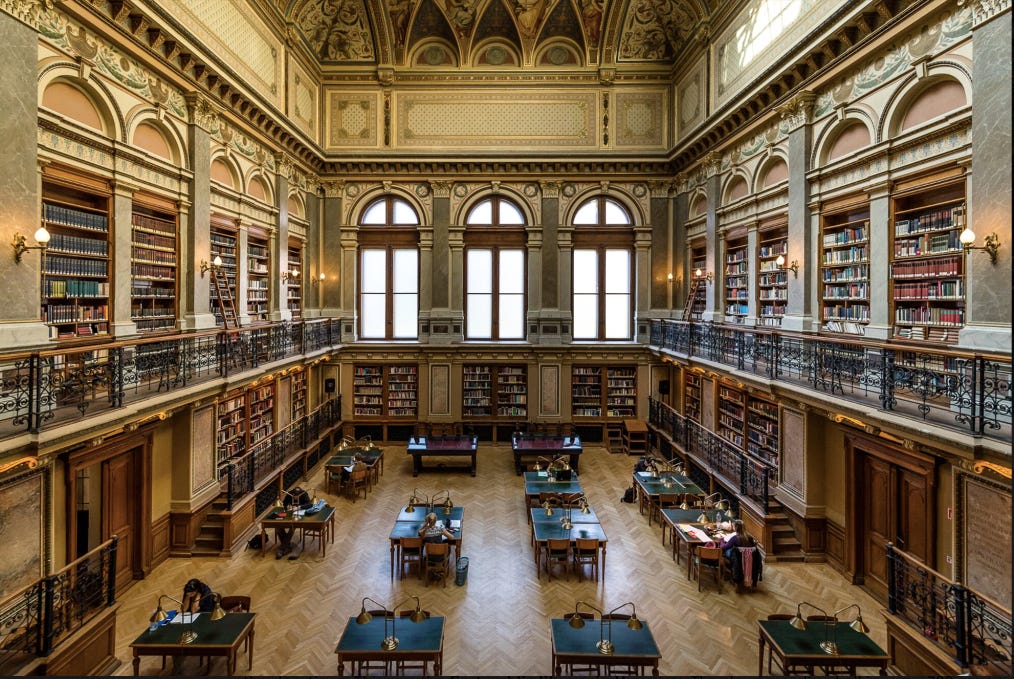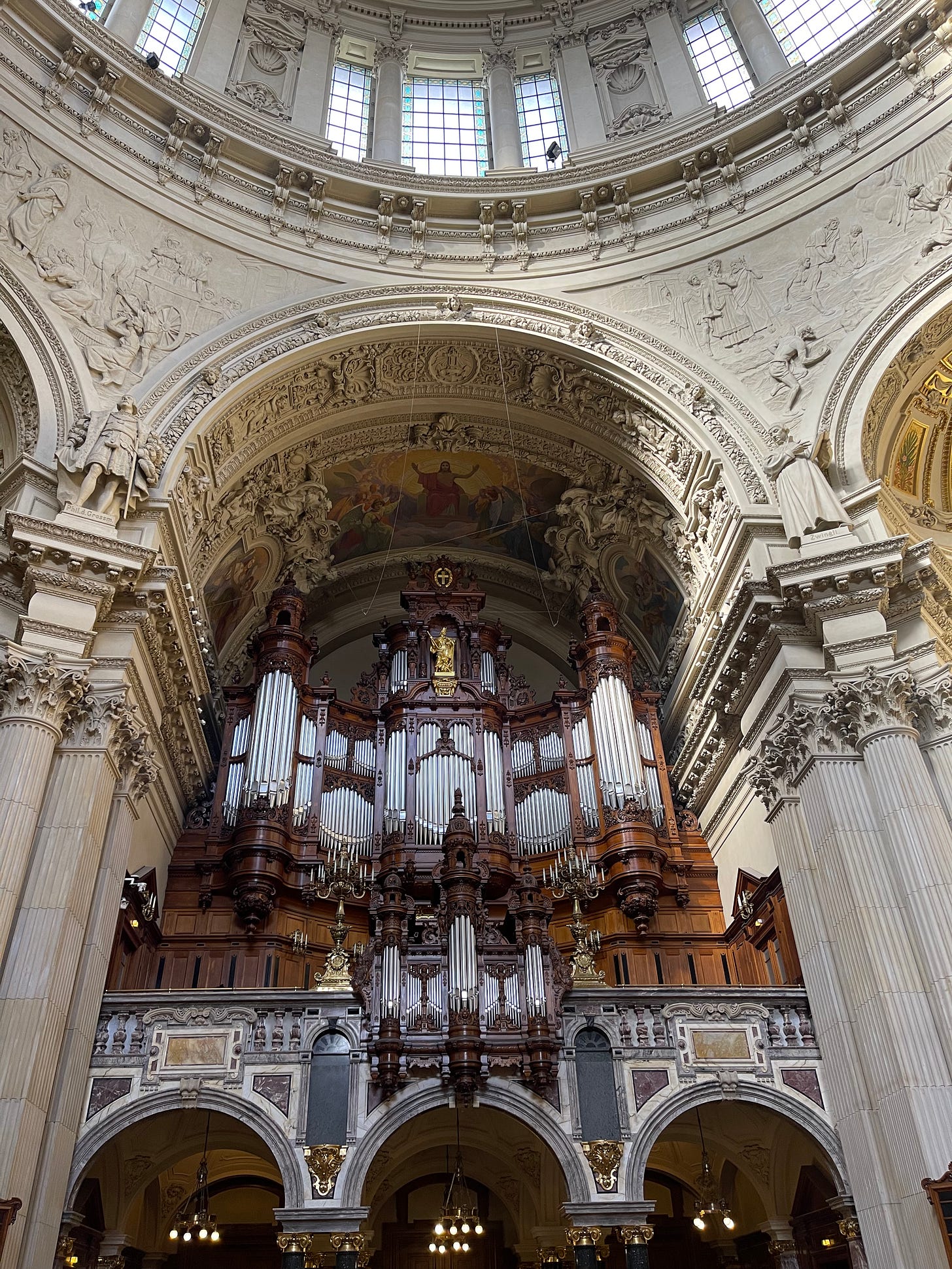Art & Revolution 🎭
You know the cliche, never say never? Well, never in 1,000 years would I think I’d be in a museum crying at a painting.
Inscrutable - impossible to understand or interpret.
Based on the outpouring of comments, emails, and texts I received from last week’s newsletter, it seems many of us are in the same boat. It's beautiful to know you aren’t alone, innit? Whether it be our first time acknowledging our desire for external stability or you’re just in one of those spaces of the unknown and radical change… I’d like to share a perspective I’ve since discovered.
This story begins in Budapest, floats through London, and ends here in Berlin. Enjoy the journey or simply scroll to the end for the gem 🗺
While in Budapest (a city that absolutely captured my heart - check my IG for the recap), I wanted to see the library and somehow found myself with a library card and a random book off the shelf, with a seat in the furthest left-hand corner. I didn’t pay much mind to what I grabbed; the goal was to end the floor from creaking under me and find a spot to enjoy the view.
The view in question:
After about 20 minutes, I figured since I was already checked in, I might as well actually read. The book I grabbed was Art in Theory. I flipped to a random chapter and within minutes, I was taken aback by the following:
“A revolution strengthens the impulse of invention. That is why there is a flourishing of art following a revolution.”
I found this to be very profound because I had never heard it articulated that way before. As of late, it feels as if we’re living in a constant state of revolt, and because of that, I was intrigued to better understand the connection between art and revolution.
*Inserts 2 weeks of reading into 2 paragraphs (check the links below for more examples)*:
Revolution, by its very nature, seeks to challenge established power structures, ideologies, and social norms, and art has been an effective tool for expressing dissent and promoting alternative visions of society. Art serves as a means of communication and inspires people to take action. The cycle of creative and political transformation continues as art influences and motivates others to push for change.
From the Russian Revolution's political posters to the Mexican Revolution's murals, art has played a crucial role in many revolutionary movements; both good and bad. Think of the treachery of Hitler’s propaganda during the Nazi’s reign or the beauty of the music, entertainment, poetry, and politics that sprouted during the Harlem Renaissance for Black America. These uprisings often lead to significant artistic movements and cultural transformations.
So it begs me to ask the question, what is the art around me attempting to convey?
I came home from Budapest and went to the Wellcome Collective here in London. You know the cliche, never say never? Well, never in 1,000 years would I think I’d be in a museum crying at a painting. Talk about catching yourself off guard 🤦🏽♀️.
It felt like one of those ‘ohhh’ moments in church when you are young and all the church aunties catch the Holy Ghost and you’re staring in fear or amusement because you don’t understand what’s transpiring. Then as you get older and life starts to life, it all makes sense. That’s how this new comprehension of art click in my head.
As I continue to open myself up to emotion, I am acutely aware of its existence outside of me. In detaching from external things, space has been created for new joys.
My new joys consist of architecture and craftsmanship. Maybe it's all the cathedrals and buildings I’ve been in recently that date back four or five centuries that you just aren’t able to see in the States. Maybe it’s the fact that I’ve been learning to take my craft as a storyteller more seriously, so I have a deeper admiration for the craftsmanship artist use to express themselves, whether it be through buildings, paintings, spoken word, or theater.
I now conclude my final thoughts on a pew here inside the Cathedral of Berlin. This was by no means intentional, but I was inspired.
I find this cathedral to be one of a kind because there’s no wasted space. From the ones I’ve seen so far (anywhere between 25-30), there’s always a mural on the ceiling, stained windows, and statues of prominent figures. However, if you look closely you can see the engraved work that’s telling a story of its own.
As a lover of history, I understood that one of the major ways it was captured was through art and architecture. Given I didn’t consider myself to fit into either category growing up (my middle school art teachers killed my artistic dreams SO QUICK), I rationalized that art was inscrutable.
However, I’m here to say art and creativity are methods of expression. Expression is a method of showing emotions. And given I have emotions, I am capable to enjoy and partake in the beauty that is art.
So for all my people who may not find themselves the typical “creative,” know that you are. If you are capable of emotion, you are capable of creating art.
Many of us are working through emotions of fear, instability, rejection, and overall discomfort. Lean into it. Be aware and sensitive to your need of finding healthy ways to express your emotions. And remember, some of the best art is created from the darkest places.
With love always,
Jamie ✈️ 🌎
Questions I’m thinking through:
What skillset would I consider myself to have?
How can I become a better craftsman with that skillset?
What emotions do I want/need to express?
How can I use my skillset to express my emotions/experience?
Links I’m loving:
Google’s Art & Culture Art & Revolution - Article
Nazism and Jim Crow South - Article
Art & Revolution - Youtube
Harlem Renaissance: 7 Artists you should know about - Youtube






Love!
Brilliant